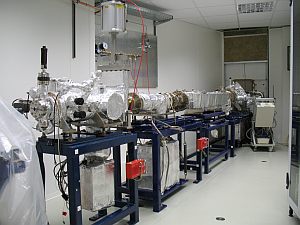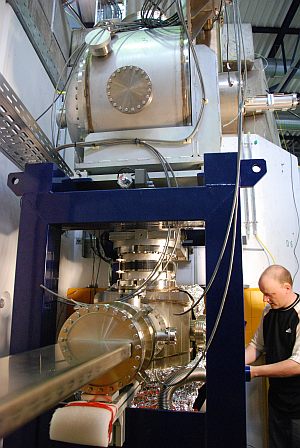The world’s first synchrotron radiation source (SRS) at the Daresbury Laboratory in England was shut down in 2008. One of its beamlines, which had been commissioned only in 2003, has now been reinstalled at KIT’s synchrotron radiation source ANKA. KIT won the competition for the beamline against strong international competition. Today, the “old new” CD12 beamline, which is used in particular for structural analysis of proteins, will be inaugurated by German and British scientists at KIT.
On 17th July 2008, the champagne corks were popping at the ANKA synchrotron radiation source of the Karlsruhe Institute of Technology (KIT). There was great rejoicing on receipt of the letter from England confirming the award of the CD12 beamline to KIT. A commission in England had made this choice from amongst a field of strong international competitors. “Then in July 2009 we could collect our new beamline at the Daresbury Laboratory in Warrington” remembers Dr. David Moss from the KIT Institute for Synchrotron Radiation, who led the reconstruction in Karlsruhe. “Since then, we have reassembled the beamline at KIT and connected it to our synchrotron radiation source ANKA.” The beamline was available because the SRS at the Daresbury Laboratory in Warrington, U.K., which was the world’s first synchrotron, had been decommissioned in 2008 after 28 years of successful operation and replaced by a new facility near Oxford.
CD12 is considered to be the world’s most powerful beamline for a spectroscopic method used in particular by biologists and medical scientists for the structural analysis of proteins and other biomolecules. This so-called UVCD technique uses circularly polarized light that can be generated in both clockwise and anticlockwise direction. The different absorption of these types of light in molecules allow conclusions to be drawn with respect to their internal structure. In addition, complementary spectroscopic methods such as FTIR (Fourier transform infrared) spectroscopy can be used at CD12. This combination makes CD12 unique in its field worldwide.

A present from England: The CD12 beamline from the Daresbury Laboratory was reinstalled at the ANKA Synchrotron Radiation Source of KIT. (Photo: KIT)
"CD12 opens up many possibilities for analyzing the structure of biomolecules,” underlines Dr. Jochen Bürck from the KIT Institute for Biological Interfaces. “Within the framework of the new BioInterfaces research program, we are particularly interested in processes taking place at cell membranes, that is the outer shell of cells, in order to find out how substances or signals penetrate into or leave a cell.”
About 30% of the measurement time at the new beamline will be used by KIT scientists. The remainder will be made available to external users from all over Europe, in accordance with ANKA’s mission as a national user facility. An independent review panel evaluates the quality of the scientific project proposals and then assigns the available beamtime. For this new beamline, however, a special regulation will apply for the next five years: the British user community will receive 20% of the measurement time and can distribute this share in its own selection procedure.
Synchrotron Radiation
In a synchrotron, elementary particles (e.g. electrons or protons) are accelerated to high energies on a circular track; in ANKA, electrons reach a final energy of 2.5 GeV (Giga electron volts = billion electron volts). The electrons then circulate at nearly the speed of light in a ring-shaped storage pipe of 110 m circumference under high vacuum. The steering of the electrons around this circular orbit is achieved with magnets. When deflected in the magnetic field, the electrons generate so-called synchrotron radiation. Synchrotron radiation is electromagnetic radiation, like sunlight or radio waves. However, synchrotron radiation has special properties that make it valuable for many applications: it covers a wide range of wavelengths, from X-rays through ultraviolet and visible light to the far infrared. Moreover, it has a high intensity and is even more parallel than laser light.
Being “The Research University in the Helmholtz Association”, KIT creates and imparts knowledge for the society and the environment. It is the objective to make significant contributions to the global challenges in the fields of energy, mobility, and information. For this, about 10,000 employees cooperate in a broad range of disciplines in natural sciences, engineering sciences, economics, and the humanities and social sciences. KIT prepares its 22,800 students for responsible tasks in society, industry, and science by offering research-based study programs. Innovation efforts at KIT build a bridge between important scientific findings and their application for the benefit of society, economic prosperity, and the preservation of our natural basis of life. KIT is one of the German universities of excellence.

